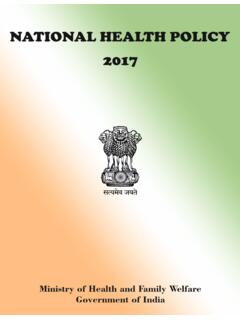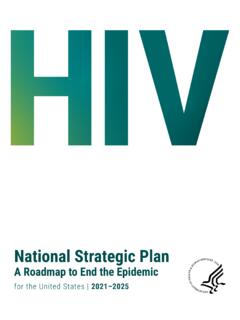Transcription of Chapter 13 Illicit drug use - World Health Organization
1 SummaryEstimating mortality directly attributable to Illicit drug use such as over-dose death the most tangible adverse heath effect of Illicit drug use is difficult because of variations in the quality and quantity of mortalitydata. As a result, it is necessary to make indirect estimates, involving esti-mates of the prevalence of Illicit drug use. However, it is difficult to makeeven indirect estimates because the use of these drugs is illegal, stigma-tized and hidden. Nonetheless, efforts must be made to estimate the contribution that Illicit drug use makes to the global burden of disease,because it is a pattern of behaviour that has a substantial adverse effecton the Health of those who engage in it. In cohort studies of treated drugusers the problematic use of Illicit drugs has been associated with anincreased overall rate of mortality, and with an elevated rate of a numberof individual causes of death, four of which were estimated here: AIDS,overdose, suicide and of the variable of interest are difficult because of deficien-cies in the data collected by countries on Illicit drug use, and by dis-agreements over what constitutes problematic Illicit drug use.
2 Thedefinition used here was long-term regular injecting use of opioids,amphetamines or cocaine. Data on the prevalence of problematic illicitdrug use were derived from a range of sources that used variable methodsof deriving literature search was conducted of all studies that estimated theprevalence of problematic drug use. Available data on prevalence incountries with data were used to estimate the prevalence of problematicillicit drug use for search was also completed for cohortstudies of drug users that had estimated mortality due to the four indi-vidual causes of death, and to all causes of death. Data on the numberof years of follow-up were extracted from each study and a weightedaverage annual mortality rate was calculated for each of the four causesChapter 13 Illicit drug useLouisa Degenhardt, Wayne Hall,Matthew Warner-Smith and Michael Lynskeyof death, and for their sum.
3 A standardized mortality ratio (SMR) wasalso derived from previous estimates of the excess mortality from allcauses attributable to Illicit drugs. Estimates were made for some causesby applying an attributable fraction obtained from sources such as theJoint United Nations Programme on HIV/AIDS (UNAIDS) (for HIV-related deaths) to estimates of total deaths for some causes. The medianestimate of a range of estimates was used as the estimate for each sub-region. Estimates were limited to persons aged 15 54 2000, the median number of global deaths attributed to Illicit drugsestimated by summing the four causes of death was 194 058. There werean additional 10 000 deaths from overdose above and beyond thosecoded as drug use disorders (added to unintentional injuries) or whencoded drug use disorder deaths were higher than estimated overdosedeaths.
4 The median 2000 estimate derived using the all-cause methodwas 197 383. Both estimates had wide uncertainty intervals around them(113 494 to 276 584 for sum of four causes; and 101 751 to 322 456 for all-cause estimates). When morbidity attributable to Illicit drug useis added to the estimated mortality, this risk factor accounts for global disability-adjusted life years (DALYs). The distribution ofnumbers of deaths between subregions varied between the two variations in the estimates reflect the considerable uncertaintyabout prevalence of drug use in different subregions and uncertaintyabout the applicability of mortality data derived in developed countriesto mortality among Illicit drug users in developing current estimates suggest that Illicit drug use is a significant causeof premature mortality among young adults.
5 This is an underestimate oftotal disease burden because: (i) there are deficits in data on mortalityattributable to the use of some Illicit drug (most notably cannabis andthe newer synthetic drugs like MDMA2); (ii) there are differences acrosssubregions in the quality of data available on the causes of mortality thatwereincluded in the current estimates; (iii) there is an absence of datathat would permit estimates of some other causes of mortality and mor-bidity attributable to Illicit drug use, such as hepatitis B and hepatitis Cand violence. There is a need for better data on: the prevalence of illicitdrug use in developed and developing countries, and on the mortalityand morbidity attributable to problematic drug use of legally proscribed psychotropic substances for non-medicalpurposes appears to be increasing in many parts of the World (Frischeret al.)
6 1994; UNDCP 2000; UNODCCP 2000) but it is difficult to quan-tify the rate of increase. It is difficult to estimate the prevalence of thisbehaviour and its adverse Health consequences in individual societiesbecause this behaviour is Illicit and therefore often hidden. Even esti-mating mortality related to Illicit drug use, the most tangible adverse1110 Comparative Quantification of Health Risksheath effect, is difficult for reasons that are discussed below (Thorley et al. 1977). Nonetheless, efforts must be made to estimate the contri-bution that Illicit drug use makes to the global burden of disease becauseit is a pattern of behaviour that has a substantial adverse effect on thehealth and well-being of those who engage in it, producing substantialloss of life and disability (Hulse et al.
7 1999).The global burden of death and disability attributable to Illicit drugswas first estimated by Donoghoe (1996), as part of the Global Burdenof Disease (GBD) project (Murray and Lopez 1996). Donoghoe esti-mated that Illicit drug use was responsible for 100 000 deaths globallyin 1990, the majority of which (62%) occurred in developing and Lopez (1996) pointed out that this estimate may be too lowbecause of difficulties in reliably estimating the prevalence of Illicit druguse and its adverse Health effects. Donoghoe s estimate was based on theattributable fractions of various causes of mortality and morbidityattributed to Illicit drug use by English et al. (1995), who reviewed allstudies published up to 1993. The great majority of these studies, whichwere principally cohort studies, were conducted in the United States ofAmerica and these estimates were made, there has been an apparent increasein Illicit drug consumption in developed societies (Australian Bureau of Criminal Intelligence 2000; EMCDDA 2000; Frischer et al.
8 1994;UNODCCP 2000), and increased incidence of HIV contracted as a resultof sharing of injecting equipment by Illicit drug users in developing soci-eties (Stimson 1993). This suggests that Donoghoe s 1990 estimates arelikely to substantially underestimate the contribution that Illicit drug usemakes to the global burden of disease in this Chapter , we have attempted to estimate the burden of disease dueto Illicit drug use by combining a range of sources of data on the preva-lence of use and indicators of outcome. We also outline the definitions ofthe exposure variable used in making estimates, and outline the causesof burden considered in this Chapter . As will become clear, estimates madeof this cause of burden are difficult to make given: (i) paucity of data onthe prevalence of Illicit drug use around the World ; (ii) the fact that dataon causes of death related to Illicit drug use are not well-recorded, so it isnecessary to rely on indirect estimates derived from inaccurate prevalenceestimates; and (iii) an absence of evidence on the risk of mortality andmorbidity due to some causes among Illicit drug variableSUBSTANCES INCLUDEDI llicit drug use includes the non-medical use of a variety of drugs thatare prohibited by international law.
9 These drugs include: amphetamine-type stimulants,3cannabis,4cocaine,5heroin6an d other opioids,7andMDMA (ecstasy). In order to estimate mortality and morbidity attrib-Louisa Degenhardt et to Illicit drug use, we need to clearly define what is and is notincluded in this risk Chapter will focus on the burden attributable to amphetamines,cocaine and opioids. Other substances that are illegal in most countries,such as ecstasy, solvents and cannabis, have not been included in thepresent analysis as there is currently insufficient research information toquantify the Health risks associated with these drugs. Thus, their exclu-sion should not be interpreted as meaning that the use of these drugs issafe. Rather, it reflects a paucity of research on the harm caused by TO DOSE, FREQUENCY AND ROUTEOF ADMINISTRATIONThe risk of premature mortality and morbidity from Illicit drug use isdependent on dose, frequency and route of administration.
10 Consequentlyit is necessary to define what is meant by use when defining the exposure variable Illicit drug use . The mortality risks of Illicit drugconsumption increase with increasing frequency and quantity of con-sumption (Fischer et al. 1997). Simple prevalence estimates of the pro-portion of the population that have ever used an Illicit drug are likely tobe associated with a low average risk since a single occasion of use andinfrequent use, the most common patterns of use reported in populationsurveys, are associated with a small increase in mortality. More accurateestimates of the burden of disease attributable to Illicit drugs require esti-mates of the prevalence of the most hazardous patterns of Illicit druguse. These are found in highest prevalence among dependent drug userswho typically inject drugs daily or near daily over periods of years.












